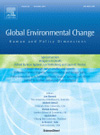-
Syria Conflict’s Connection to Climate Change, and Avoiding Maladaptation to “Hydro-Climate” Risks
April 1, 2015 By Theo Wilson In a headline–making article in the journal PNAS, Colin P. Kelley et al. write there is evidence that the ongoing conflict in Syria, which has killed at least 200,000, was triggered by climate change. Severe drought from 2007 to 2010 caused a massive rural-to-urban demographic shift which exacerbated pre-existing sociopolitical tensions in Syrian cities already inundated with Iraqi refugees. The government’s poor agricultural and water management policies, coupled with rapid population growth, greatly increased vulnerability to the effects of the drought. While the region has undergone 80 years of consecutive droughts, “the four most severe droughts occurred in the last 25 years, the period during which external anthropogenic forcing has seen its largest increase,” write the authors. Under simulations of regional weather trends with and without the influences of anthropogenic greenhouse gas concentrations, they found “the driest 3-year events occur less than half as often under natural forcing alone.” The authors conclude that the Syrian people, already vulnerable from economic policy failures and sociopolitical unrest, were pushed beyond their coping thresholds – a scenario they predict could be repeated elsewhere in the Levant.
In a headline–making article in the journal PNAS, Colin P. Kelley et al. write there is evidence that the ongoing conflict in Syria, which has killed at least 200,000, was triggered by climate change. Severe drought from 2007 to 2010 caused a massive rural-to-urban demographic shift which exacerbated pre-existing sociopolitical tensions in Syrian cities already inundated with Iraqi refugees. The government’s poor agricultural and water management policies, coupled with rapid population growth, greatly increased vulnerability to the effects of the drought. While the region has undergone 80 years of consecutive droughts, “the four most severe droughts occurred in the last 25 years, the period during which external anthropogenic forcing has seen its largest increase,” write the authors. Under simulations of regional weather trends with and without the influences of anthropogenic greenhouse gas concentrations, they found “the driest 3-year events occur less than half as often under natural forcing alone.” The authors conclude that the Syrian people, already vulnerable from economic policy failures and sociopolitical unrest, were pushed beyond their coping thresholds – a scenario they predict could be repeated elsewhere in the Levant. “Research on security and climate change must move beyond narrow investigations of conflict and study the links between structural violence and human insecurity,” write Christos Zografos, Marisa C. Goulden, and Giorgos Kallis in an article for Global Environmental Change. Presenting the results of the Climate Change, Hydro-Conflict, and Human Security Project, a collaborative research effort funded by the European Commission which the authors participated in, they write that political and economic factors are the key drivers of human insecurity. By illuminating power relations within the political economy, the authors reveal how violence is built into systems, rather than a response to “hydro-climate stressors.” For example, democratic governance structures can significantly reduce the potential for conflict, they write, and adaptation policies derived and implemented by the state sometimes undermine the stability of vulnerable social groups. “Planned adaptation in the form of relocation may reduce risks from some hydro-climatic stressors (sea-level rise and flood risk) but undermine human security in other ways, for example by reducing livelihood security and social networks,” they write.
“Research on security and climate change must move beyond narrow investigations of conflict and study the links between structural violence and human insecurity,” write Christos Zografos, Marisa C. Goulden, and Giorgos Kallis in an article for Global Environmental Change. Presenting the results of the Climate Change, Hydro-Conflict, and Human Security Project, a collaborative research effort funded by the European Commission which the authors participated in, they write that political and economic factors are the key drivers of human insecurity. By illuminating power relations within the political economy, the authors reveal how violence is built into systems, rather than a response to “hydro-climate stressors.” For example, democratic governance structures can significantly reduce the potential for conflict, they write, and adaptation policies derived and implemented by the state sometimes undermine the stability of vulnerable social groups. “Planned adaptation in the form of relocation may reduce risks from some hydro-climatic stressors (sea-level rise and flood risk) but undermine human security in other ways, for example by reducing livelihood security and social networks,” they write.Sources: Global Environmental Change, PNAS.
 A Publication of the Stimson Center.
A Publication of the Stimson Center.





